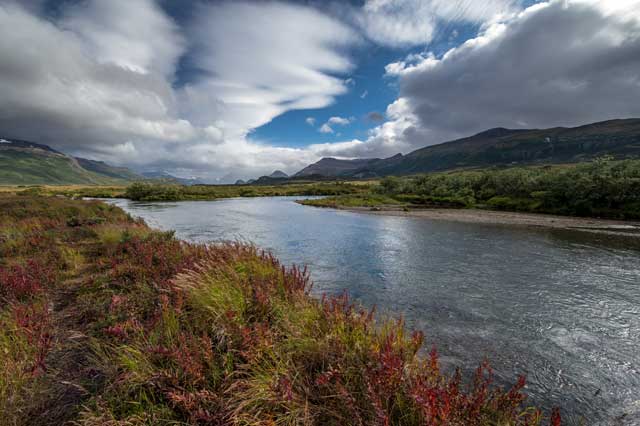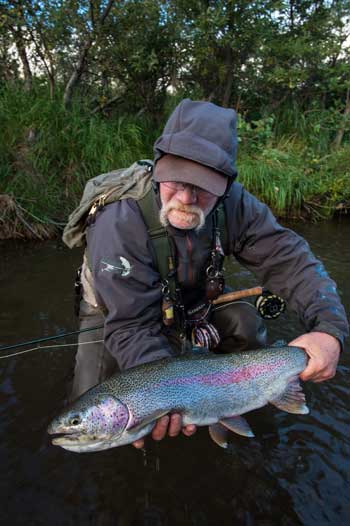Pebble Mine Support Begins to Collapse
I’d been in beautiful Lake Placid, New York, for a couple of days already at the Outdoor Writers Association of America annual meeting when Whit Fosburgh waved me over to his table to join him for lunch. Fosburgh is the CEO of the Theodore Roosevelt Conservation Partnership (TRCP), the mission of which is to strengthen the laws and public policy that affect fish and wildlife conservation to ensure that all generations of Americans have high-quality places to hunt and fish. I’d stayed an extra day at the conference solely to hear Fosburgh speak about the sportsmen’s issues facing the next Congress—so naturally I was delighted to join his table for lunch before hitting the road back to Virginia.

Jim Klug photo
And as crowds go, the table was an outdoor writer’s dream team: Outdoor writer Mark Freeman of the Mail Tribune (Oregon) sat next to me. Beside him sat Todd Tanner of Sporting Classics. Rounding out the table were TRCP Director of Media Relations Katie McKalip; Field & Stream field editor Keith McCafferty, who is also the author of fly fishing mystery novels; Brett Prettyman of The Salt Lake City Tribune; and Scott Hed, who for nearly a decade has worked tirelessly toward one goal: stopping Pebble Mine.
Perhaps you’ve heard of Pebble Mine. This enormous project centers on extracting copper, gold, and other minerals from a remote section of Alaska’s Bristol Bay region. Proponents of the project point out that it would generate lots of profits and lots of jobs—both a significant boon to the economy of the state. Opponents counter that any mining mishaps would threaten what is arguably the most productive salmon fishery in the world. This year the EPA determined that the project would impair some 90 miles of salmon stream. But what has really concerned sportsmen like Scott Hed are the spoil piles that such an operation would create and the long-term threat that they—and their accidental release—would pose. At the center of the Pebble Mine project is Northern Dynasty of Vancouver, which has never overseen an operation of this scale before. Critics argue that Bristol Bay is hardly the place to gain on-the-job experience.
Imagine our surprise when Hed announced to the table that London-based mining interest Anglo American, which has already invested $300 million in the project and is Northern Dynasty’s erstwhile partner in the Pebble Mine with a 50 percent stake, had exercised its option to dissolve the partnership. Critics hope that this development sounds the death knell of the mine; Northern Dynasty, however, is unlikely to throw in the towel on such a large and potentially lucrative venture. Although it may take some time to dissolve the partnership, Northern Dynasty’s press release suggests that the company will soon be on the hunt for a new partner.
So why did Anglo American walk away from Pebble Mine? In its own statement, Anglo American has said its decision was made on the basis of economics. But public antipathy and vocal opposition might also have swayed decision makers: Of the 895,000 who weighed in during the EPA’s public comment period, 654,000 opposed to the project. This represents roughly 73 percent of those who commented—but among Alaskans only, the percentage opposed to the project is much, much higher. What explains the widespread and very vocal opposition to Pebble Mine? Simply put, the mine’s chief opponents—folks like Scott Hed—have been tireless in mobilizing stakeholders, from the grass roots up, to speak out against the project.
Hed is an unassuming fellow, and unless you’re a conservationist or an Alaskan fisherman, you probably didn’t know his name. Though he sounded the alarm on Pebble Mine, Hed’s no alarmist—and this might help to explain his success. He’s humble, he maintains a low profile, he eschews controversy, he reaches out to commercial fishermen, he’s discreet, he avoids generalizations, and he is able to disagree without being disagreeable. Scott Hed, who heads up the Sportsman’s Alliance for Alaska,, sincerely believes that development of the Pebble Mine could have significant adverse impacts on the greatest wild salmon fishery on earth—and yet he’s no Chicken Little. Instead he patiently explains to anyone who will listen that the project’s potential profits are more than offset by its tremendous risk to the Bristol Bay watershed.

Jim Klug photo
Hed’s patient instruction has paid off. Industry leaders like Orvis, Simms, American Fly Fishing Trade Association, and Yellow Dog Flyfishing Adventures have joined Trout Unlimited, TRCP, and the Federation of Fly Fishers—but then we expect such organizations to lead the way on environmental stewardship. More surprising is the campaign’s support from commercial anglers as well as hunting lodges, guides, and the public. Alaskans are fiercely independent and tend to bristle at what they perceive as federal meddling in their efforts to harvest or extract their state’s bountiful natural resources. Consider then that Alaskans and commercial fishing interests and fishing and hunting lodges have asked the EPA to intervene to stop the mine.
For years, Whit Fosburgh has argued that sportsmen need to be more involved. “The hunting and fishing community could wield a great deal of influence in how we manage our natural resources if we simply take the time to contact our legislators.” Indeed, sportsmen are an enormous and economically significant interest group—but because they’re essentially a sleeping giant, they are largely ignored by policymakers.
At lunch, Scott Hed didn’t pull any punches: “This doesn’t mean the end of Pebble Mine. We shouldn’t open the champagne bottles just yet. We aren’t against mining,” he insisted. “The groups I work with adamantly oppose mining here. This area is unlike any other place on earth, and if mining can occur here in Bristol Bay, which more or less amounts to the crown jewel of Alaska, it can happen anywhere.”
Beau Beasley (www.beaubeasley.com) is an investigative outdoor journalist who specializes in saltwater baitfish as well as river access and use issues. He lives with his wife and children in Warrenton, Virginia.
Video Hatch: "Rare Trout: The Greenback"
Fish and Floods











